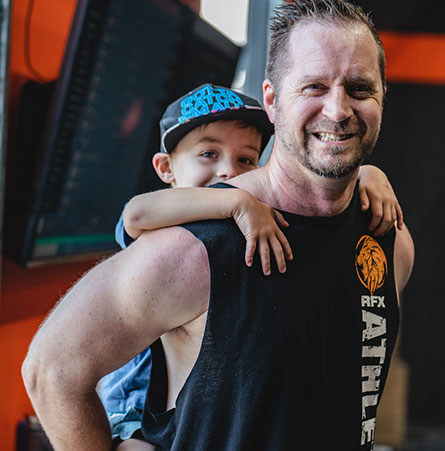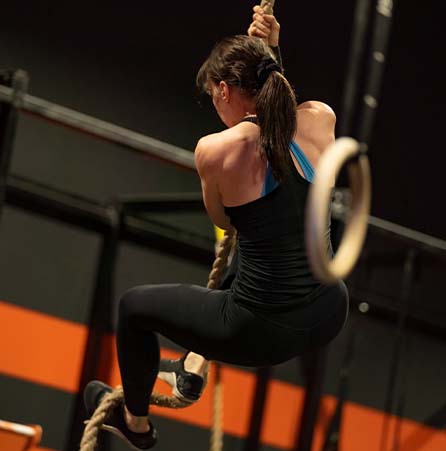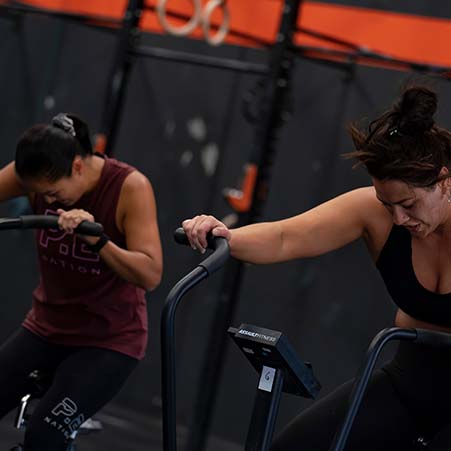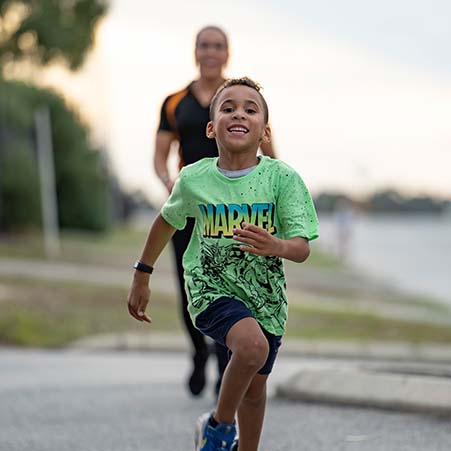Scaling workouts in CrossFit is all about making fitness accessible for everyone, regardless of their starting point. Whether you’re a newbie or a seasoned athlete, knowing how to adjust workouts can help you get the most out of your training. In this article, we’ll explore the philosophy behind scaling CrossFit workouts, share practical examples, and discuss how coaches play a vital role in this process. Plus, we’ll dive into the benefits of scaled workouts and how to create a plan that works for you.
Key Takeaways
- Scaling is essential for making CrossFit accessible to all fitness levels.
- Proper scaling can help prevent injuries and improve workout consistency.
- Coaches are crucial in guiding athletes through the scaling process safely.
- New athletes can build confidence and set realistic goals through scaling.
- A supportive community enhances the experience of scaled CrossFit workouts.
Understanding The Philosophy Of Scaling In CrossFit
CrossFit is known for its intensity, but what if you’re just starting out, or have some limitations? That’s where scaling comes in. Scaling isn’t about making the workout easier; it’s about adjusting it so that anyone, regardless of their current fitness level, can safely and effectively participate. It’s a fundamental part of CrossFit’s inclusivity.
The Importance Of Individualisation
CrossFit isn’t a one-size-fits-all programme. Individualisation is key to ensuring everyone gets the most out of each workout. This means understanding your own body, its strengths, and its limitations. Maybe you can’t do a full pull-up yet, or perhaps your knees aren’t happy with deep squats. That’s perfectly fine! Scaling allows you to modify the exercises to suit your needs, ensuring you’re still challenged but not risking injury. It’s about meeting you where you are and helping you progress safely.
Benefits Of Scaling For Injury Prevention
Jumping into advanced movements before you’re ready is a recipe for disaster. Scaling helps prevent injuries by allowing you to build a solid foundation of strength and technique. It’s better to do a modified version of an exercise with perfect form than to struggle through the full version and risk hurting yourself. Think of it as building a house – you need a strong foundation before you can start adding the walls and roof. Scaling ensures you’re building that foundation properly.
How Scaling Enhances Consistency
Let’s be honest, if every workout leaves you feeling defeated and in pain, you’re not going to stick with it for long. Scaling makes CrossFit more accessible and enjoyable, which in turn, makes it easier to stay consistent. When you’re able to complete workouts (even if they’re modified), you feel a sense of accomplishment, which motivates you to keep coming back. And that’s what it’s all about – finding a fitness routine that you can stick with for the long haul.
Scaling is not a sign of weakness; it’s a sign of intelligence. It demonstrates an understanding of your own body and a commitment to long-term progress. It’s about working smarter, not just harder.
Examples Of Scaled CrossFit Workouts
Scaling in CrossFit isn’t just about making things easier; it’s about making them appropriate for where you are on your fitness journey. It’s about ensuring everyone, regardless of their experience, can participate and benefit from the workout. Let’s look at some practical examples of how this works.
Substituting Movements For Accessibility
Sometimes, a particular movement might be too advanced or inaccessible due to injury or mobility restrictions. That’s where substitutions come in. For example, if pull-ups are prescribed, but you can’t do them yet, we might substitute them with ring rows or banded pull-downs. The goal is to find an alternative that works similar muscle groups and provides a comparable stimulus. This is a key part of personalised CrossFit programming.
Here’s a quick guide:
- Pull-ups: Substitute with ring rows or banded pull-downs.
- Handstand Push-ups: Substitute with push-ups on knees or against a wall.
- Box Jumps: Substitute with step-ups.
Adjusting Reps And Sets
Another common scaling method involves adjusting the number of repetitions (reps) and sets. If a workout calls for five rounds of 20 repetitions, a beginner might start with three rounds of 10 repetitions. This reduces the overall volume and intensity, making the workout more manageable. It’s all about finding that sweet spot where you’re challenged but not overwhelmed.
Modifying Intensity For All Levels
Intensity can be modified in several ways, such as reducing the weight lifted, decreasing the range of motion, or slowing down the pace. For example, if the workout includes deadlifts at 100kg, a beginner might start with 40kg or even just use a PVC pipe to focus on form. Similarly, a full squat can be modified to a partial squat if needed. This ensures that everyone can participate in scaled CrossFit workouts safely and effectively, regardless of their current fitness level. It’s important to understand how to modify CrossFit for beginners to prevent injuries and promote long-term progress.
Scaling isn’t about taking the easy way out; it’s about making smart choices that allow you to participate fully and safely in the workout. It’s about respecting your body and your current abilities while still pushing yourself to improve.
The Role Of Coaches In Scaling Workouts
Coaches are super important when it comes to scaling CrossFit workouts. They’re not just there to yell encouragement; they play a vital role in making sure everyone gets a safe and effective workout, no matter their fitness level. It’s about individualising the experience and creating a supportive environment where everyone can thrive. Let’s look at how they do it.
Guidance On Proper Form And Technique
One of the most important things a coach does is teach proper form and technique. It’s easy to get injured if you’re not doing the movements correctly, especially when you’re pushing yourself. Coaches keep a close eye on everyone, correcting posture and alignment to prevent injuries. They’ll break down complex movements into smaller, more manageable steps, ensuring everyone understands the basics before adding weight or intensity. This focus on technique not only keeps you safe but also helps you get the most out of each exercise. For instance, a coach can show you proper form for a clean and jerk, ensuring you’re using your legs and core effectively, rather than straining your back.
Personalised Modifications For Safety
Everyone’s body is different, and what works for one person might not work for another. Coaches are skilled at providing personalised modifications to exercises based on individual needs and limitations. If someone has a past injury or physical limitation, the coach can suggest alternative movements that are just as effective but less risky. This might involve using lighter weights, reducing the range of motion, or substituting an exercise altogether. The goal is to make sure everyone can participate safely and effectively, regardless of their physical condition. It’s about finding the right balance between pushing yourself and staying within your limits. This personalised approach ensures you focus on exercises that provide the best results.
Creating A Supportive Environment
CrossFit can be intimidating, especially for beginners. Coaches play a big role in creating a supportive and inclusive environment where everyone feels comfortable and encouraged. They foster a sense of community, where people support each other and celebrate each other’s successes. This might involve pairing up athletes of different levels, so more experienced members can offer guidance and encouragement to those who are just starting out. Coaches also provide positive reinforcement and motivation, helping people stay committed to their fitness goals. A supportive environment can make all the difference in helping people overcome their fears and push themselves to achieve more than they thought possible.
A good coach understands that scaling isn’t just about making workouts easier; it’s about making them appropriate for each individual. It’s about creating a challenging but achievable experience that helps everyone improve their fitness and build confidence.
Encouraging New Athletes To Start Safely
CrossFit can seem intimidating, especially for newcomers. The intensity and advanced movements often seen online might create the impression that it’s only for elite athletes. However, the beauty of CrossFit lies in its scalability. It’s designed to be modified to suit any fitness level, making it accessible and safe for everyone, including those just starting their fitness journey. Let’s explore how we can encourage new athletes to start safely and build a solid foundation.
Overcoming Hesitations About CrossFit
One of the biggest hurdles is addressing the misconceptions surrounding CrossFit. Many people believe you need to be in peak physical condition to even attempt it. It’s important to emphasise that CrossFit is about personal progress, not about comparing yourself to others. Every workout can be scaled to match your current abilities.
- Highlight success stories of individuals who started with little to no fitness experience and have thrived in CrossFit.
- Offer introductory sessions that focus on fundamental movements and scaling options.
- Create a welcoming and inclusive environment where questions are encouraged and modifications are readily available.
Building Confidence Through Scaling
Scaling is the key to building confidence in CrossFit. It allows new athletes to participate fully in workouts while working within their limitations. This approach not only prevents injuries but also fosters a sense of accomplishment and progress. RFX CrossFit Athletic provides modifications to help you build strength and confidence while maintaining proper form and safety.
- Start with simpler versions of movements, such as box step-ups instead of box jumps, or ring rows instead of pull-ups.
- Reduce the weight used in exercises to focus on proper form and technique.
- Adjust the number of repetitions or rounds to match your current fitness level.
Setting Realistic Goals For Progress
Setting realistic goals is crucial for maintaining motivation and preventing burnout. New athletes should focus on mastering fundamental movements and gradually increasing intensity and complexity over time. It’s not about achieving elite status overnight; it’s about consistent progress and long-term health. RFX coaching for all abilities helps you focus on exercises that provide the best results.
It’s important to remember that fitness is a journey, not a destination. Celebrate small victories, focus on consistency, and be patient with your progress. With the right approach and support, anyone can achieve their fitness goals through scaled CrossFit workouts.
- Encourage athletes to track their progress and celebrate milestones.
- Provide regular feedback and guidance to help athletes stay on track.
- Emphasise the importance of rest and recovery to prevent overtraining and injuries.
Benefits Of Scaled CrossFit Workouts
CrossFit, when scaled correctly, offers a stack of benefits that go beyond just physical fitness. It’s about making the workouts accessible and effective for everyone, no matter their current fitness level. Let’s look at some key advantages.
Improved Functional Fitness
CrossFit focuses on functional movements, which mimic everyday activities. Think squats, deadlifts, and overhead presses. When these movements are scaled appropriately, they improve your strength, mobility, and balance in ways that directly translate to real-life tasks. This means you’ll find it easier to lift groceries, climb stairs, and generally move with more confidence and ease. It’s about building a body that’s not just strong in the gym, but strong in the world.
Enhanced Enjoyment And Engagement
Let’s be honest, if a workout is too hard or too easy, you’re not going to stick with it. Scaling ensures that the workout is challenging but achievable, which makes it more enjoyable. This increased enjoyment leads to better engagement and consistency. Plus, when you see yourself progressing, it’s a massive motivator to keep going. This is especially important when considering beginner CrossFit tips.
Increased Community Support
CrossFit boxes are known for their strong sense of community. When workouts are scaled, everyone can participate and feel like they’re part of the team. This shared experience creates a supportive environment where people encourage each other, celebrate successes, and offer help when needed. It’s about building relationships and finding a tribe that supports your fitness journey. Learning how to scale WODs without injury is important for everyone in the community.
Scaling isn’t just about making things easier; it’s about making them right for you. It’s about finding the sweet spot where you’re challenged, but not overwhelmed, and where you can progress safely and effectively.
Creating A Scalable Workout Plan
So, you’re keen to build a workout plan that actually works for everyone, no matter their fitness level? Awesome! It’s not as tricky as it sounds. It’s all about understanding where people are at and making smart adjustments. Let’s break it down.
Assessing Individual Fitness Levels
First things first: you need to know your starting point. What can your athletes actually do? Don’t just guess. Have them do some basic movements to gauge their strength, endurance, and mobility. Can they do a proper squat? How many push-ups can they manage? This isn’t about judging; it’s about getting a realistic picture.
- Consider a simple fitness test.
- Ask about their training history.
- Observe their movement patterns.
Incorporating Variety In Workouts
Nobody wants to do the same thing day in, day out. Keep things interesting by mixing up the exercises, rep schemes, and workout formats. This not only prevents boredom but also helps develop a more well-rounded level of fitness. Think about including different types of movements – pushing, pulling, squatting, hinging – and varying the intensity and duration. This approach to CrossFit effectively builds strength.
Tracking Progress And Adjustments
This is where the magic happens. You need to track how your athletes are progressing and adjust the workouts accordingly. If someone is smashing their goals, it’s time to increase the difficulty. If they’re struggling, it’s time to scale back. Keep a record of their workouts, reps, and weights, and regularly check in with them to see how they’re feeling.
Think of it like this: a workout plan isn’t set in stone. It’s a living, breathing thing that needs to be constantly tweaked and adjusted to meet the needs of the individual. Don’t be afraid to experiment and try new things. The goal is to find what works best for each person and help them achieve their fitness goals.
Here’s a simple way to track progress:
|
Date |
Workout |
Weight/Reps |
Notes |
|
2025-04-16 |
Squats | 50kg x 5 |
Felt strong, could increase next time |
|
2025-04-16 |
Push-ups | 10 | Good form, consistent |
| 2025-04-16 | Pull-ups (Assisted) | 3 x 5 |
Need to work on grip strength |
Long-Term Success With Scaled Workouts
It’s one thing to start CrossFit, but it’s another to stick with it and see real, lasting results. Scaling workouts plays a massive role in your long-term success. It’s not just about making things easier; it’s about building a solid foundation, preventing injuries, and keeping you motivated to come back for more. Let’s look at how to make scaled workouts work for you in the long run.
Maintaining Motivation Over Time
Staying motivated is key to any fitness journey. Scaled workouts help keep things interesting and achievable. When you’re constantly pushing yourself too hard or attempting movements beyond your current ability, it’s easy to get discouraged. Scaling allows you to experience progress regularly, which fuels your motivation. Think of it as building blocks: each scaled workout is a block that contributes to a stronger, more confident you. Plus, variety is the spice of life! Mixing up your scaled workouts keeps your body challenged and your mind engaged. RFX Athletic can help you maintain consistency with CrossFit during busy times.
Adapting As Fitness Levels Change
As you get fitter, your scaled workouts need to evolve. What was once a challenging modification might become too easy. This is where understanding progressions vs. regressions in workouts comes in. Progressions are about making the workout harder as you improve, while regressions are about scaling back when needed (due to injury, fatigue, or other factors). It’s a constant dance of adjusting the intensity, reps, weight, or movements to match your current fitness level. Don’t be afraid to experiment and find what works best for you. Listen to your body and adjust accordingly.
The Importance Of Community In Progress
CrossFit is more than just a workout; it’s a community. Being part of a supportive group can make all the difference in your long-term success. Your fellow CrossFitters can offer encouragement, advice, and accountability. They can also help you see your progress and celebrate your achievements. Don’t underestimate the power of shared experience and camaraderie. Find a supportive environment that motivates you to keep going, even when things get tough.
Scaling isn’t a sign of weakness; it’s a smart strategy for long-term growth and enjoyment. Embrace the process, celebrate your progress, and remember that every scaled workout is a step towards a fitter, healthier you.
Here are some ways the community can help:
- Accountability: Having workout buddies keeps you on track.
- Motivation: Seeing others achieve their goals inspires you.
- Advice: Experienced members can offer tips and support.
To achieve lasting success with scaled workouts, it’s important to stay consistent and listen to your body. Start with manageable exercises and gradually increase the intensity as you get stronger. Remember, the goal is to improve over time, not to rush. For more tips and to join our community, visit our website today!
Wrapping It Up
Scaling CrossFit workouts is all about making fitness accessible for everyone, no matter where you’re starting from. It’s not just about lifting heavy weights or completing a workout as fast as possible; it’s about finding what works for you. Whether you’re swapping out movements, adjusting the number of reps, or changing the intensity, the goal is to keep you safe and motivated. At RFX, our coaches are here to help you every step of the way, ensuring you get the most out of your workouts. So, if you’re new to CrossFit or feeling a bit unsure, don’t hesitate to jump in. You’ll find a supportive community ready to cheer you on as you work towards your fitness goals.
Frequently Asked Questions
Is CrossFit a good choice for beginners?
Absolutely! CrossFit is designed to be adjustable for everyone, including beginners. At RFX, our trainers help modify workouts so they are safe and effective for all fitness levels.
How often should I do CrossFit?
For the best results, aim for 3 to 5 sessions each week. However, this can vary based on your personal fitness level and goals. Our coaches can help you find the right routine.
Can CrossFit help with weight loss?
Yes, it can! CrossFit combines strength training and high-energy cardio, making it a great way to lose fat while keeping your muscles.
What happens in a typical CrossFit class?
In a usual class, you’ll start with a warm-up, then do some strength training, followed by the Workout of the Day (WOD), and finish with a cool-down.
Why should I choose RFX Athletic?
At RFX, we offer expert coaching, a friendly community, and structured programmes that cater to everyone, helping you reach your fitness goals.
How does scaling work in CrossFit?
Scaling means adjusting workouts to fit your fitness level. This can include changing exercises, lowering weights, or modifying the number of repetitions to ensure everyone can participate safely.





